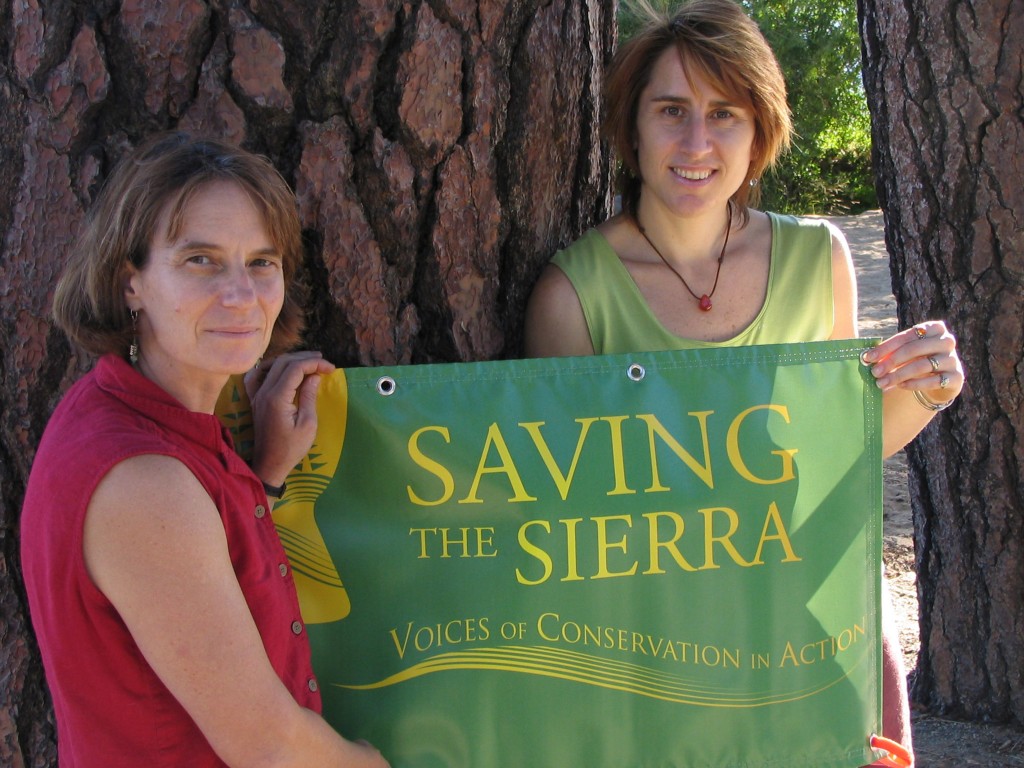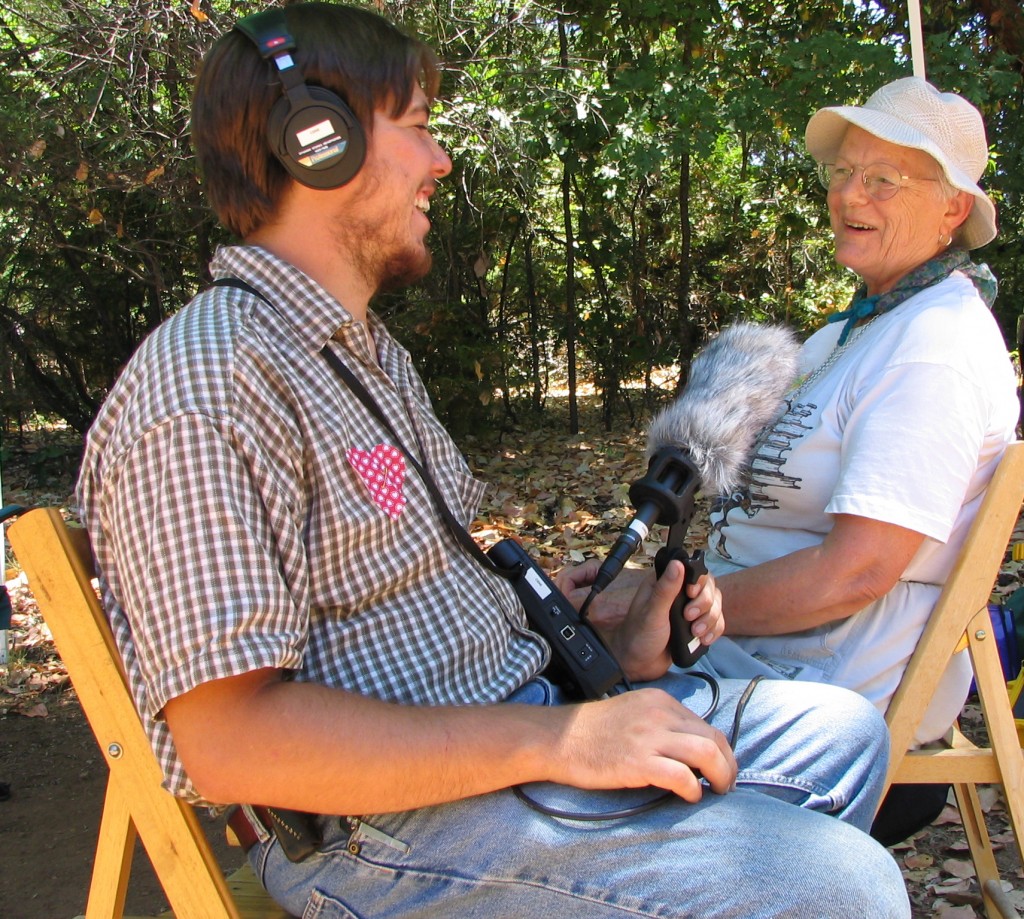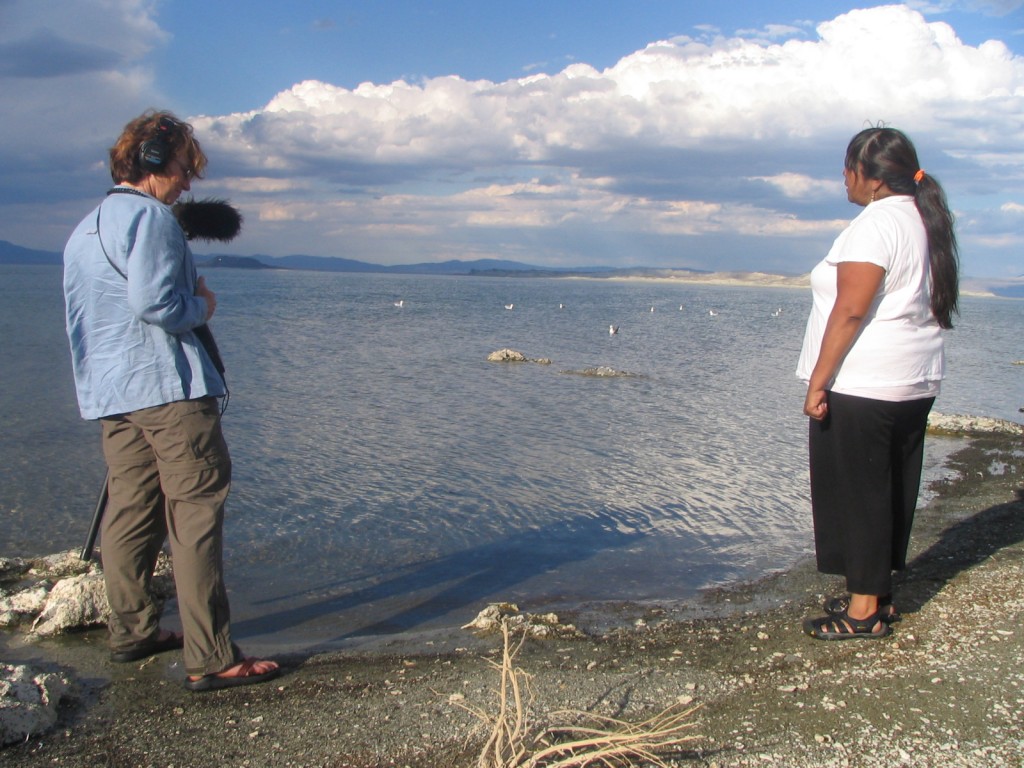By jesikah maria ross and Catherine Stifter
This article was originally published in AIRblast, the electronic publication of AIR, the Association of Independents in Radio, Inc.—this updated version is presented with their permission.Our 21/2-year multi-media project, Saving The Sierra: Voices of Conservation in Action, is now over. The digital files are all tucked into a nice big hard drive and we’ve recycled all but the most important papers. But before we head off our next adventure in independent, social issue media making, we’d like to share a few lessons learned along the way that any producer could use in planning a national multiplatform documentary special.
Saving The Sierra, (STS), was a through-and-through collaboration, co-directed by a public radio producer (Catherine Stifter) and a community cultural developer (jesikah maria ross). Together, we came up with an ambitious plan to tell the stories of what rural folks are doing at the “dirt-level” to conserve the environment, economy and culture of California’s Sierra Nevada—a 400-mile-long mountain range with two million inhabitants. We set out to talk to everyone from Native Americans and ranchers to students and Sierra Clubbers. The work of regional scholars guided our inquiry.
TIP #1 HAVE A CLEAR ORGANIZING PRINCIPLE THAT DRIVES YOUR PROJECT
STS was rooted in social networking. By definition, the project flipped the usual approach to creating and distributing a documentary upside-down: instead of starting with a radio program, we began by simultaneously building two platforms in two places: 1) on-the-ground, with individuals and organizations engaged in conservation throughout the bio-region, and 2) online, with web stories and news from the same sources. Our goals were to build a deep understanding of the issues and a foundation of community connections that would help us to make better radio, and to ensure that our investment in research and program production had maximum impact.
We invited three community organizations to be our key partners and advisors: The Sierra Fund (our fiscal sponsor), the Center for Sierra Nevada Studies at Sierra College, and the Sierra Nevada Alliance. Then we wrote a successful grant proposal to the California Documentary Project of the California Council for the Humanities.
Our first media production was a mobile “storybooth” (thanks for the inspiration, David Isay!) that traveled around the mountain range, taking the pulse of the region. Within six months, we launched an info-packed website with 100 webstories (audio narratives with a few still images) plus a blog by local writers. By the end of the first year we’d gathered nearly 100 subscribers to the project eNewsletter, made appearances on regional radio talk shows and in many local papers, raised $16,000 from individual donors, produced a three-part feature series for statewide public radio news magazine The California Report and won the Dottie Award for Best Arts and Cultural Website in Northern California.
Note that we did all of this BEFORE we produced a minute of national radio programming—a departure from previous production routines.
Early in the second year, we convened an advisory council to help shape an hour-long national public radio documentary. We agreed that the most compelling stories were about rural communities facing threats of urban development. And we believed we could tell that story from the Sierra in a way that would resonate with audiences everywhere. We consciously kept a regional focus because: 1) our goals and resources only stretched that far, and 2) we were committed to working from inside the community that we had come to know well.
TIP #2 CROWDSOURCE WITH YOUR PEERS AND ALLIES
Many of us belong to national organizations set up to support independent media makers by offering peer e-networking, technical assistance, and other member services. Use them! Our project kicked off with an Association of Independent Radio (AIR) mentorship with attorney Ernie Sanchez. He helped us write a Memorandum of Understanding (MOU) with our fiscal sponsor, who had never before worked with media partners, and with our collaborating organizations. STS also relied on free words of advice from many AIR members through their daily email digest and later paid more than half a dozen to work in editorial, production and marketing roles.
TIP #3 CULTIVATE THE RIGHT FUNDER
It comes back to Fundraising 101: you need to really understand your project in order to write a good funding proposal or donor appeal. Do your homework until you find that perfect match between your project and a funder who appreciates what you want to accomplish.
The California Council of Humanities was a great match for Saving The Sierra. However, all but one of our seven subsequent grant applications were turned down. We weren’t solely broadcast. We were regional, not national. And we weren’t doing on-the-ground conservation activities either. We didn’t conveniently fit into a box.
The Morgan Family Foundation was the one that finally came through. We stayed in regular contact with an officer for nearly two years before our efforts paid off. The foundation partnered with the Sierra Business Council to provide $20,000 to reach urban audiences. This money helped us upgrade our website to make it truly interactive, and create an online listener toolkit as a companion for our documentary.
TIP #4 ENTER INTO SYMBIOTIC RELATIONSHIPS WITH PROJECT PARTNERS
Producers often look for partnerships in a self-interested way. Our criteria for partners included community-based organizations with a Sierra-wide reach that could serve as project advisors, whose members could inform our research through their participation in our digital storybooth, and who could benefit from both the online and broadcast media we produced. We agreed to journalistic firewalls and wrote MOUs that spelled out each party’s roles and responsibilities. The MOUs gave us editorial control and copyright of the “produced materials” (everything from workshop curriculum to web content to radio pieces), but granted partners a non-exclusive license to use these materials—which we encouraged– without payment during the life of the project. Here are just a few examples of our symbiotic relationships.
We presented a storytelling workshop for the Sierra Nevada Alliance annual conference to help increase the capacity of conservationists to tell compelling stories about their work. More than two dozen members ended up contributing to our Sierra Nevada Virtual Museum, the website of the Center for Sierra Nevada Studies at Sierra College. We provided training in digital media for college interns who traveled with our mobile storybooth. Our website was originally designed by a faculty/student team from the computer art department at the college. This was another example of leveraging resources to support mutual goals.
TIP #5 STAY ON THE CUTTING EDGE OF SOCIAL NETWORKING, EVEN IF YOU BLEED A LITTLE
We see more and more fellow mediamakers on Facebook, Twitter and other social media sites. Dmae Roberts’ Facebook group for her new radio documentary, “Coming Home,” had more than 50 members and a Flash movie, before she completed production.
Visitors to the STS website can rate, comment on, and share our digital stories on any of the social networking sites. All of our media can be downloaded and we make it available for use, with attribution, through Creative Commons licensing. We get 100 new visitors to our website each week, without doing any additional outreach, and our documentary is podcast on the WGBH Forum and iTunes.
We also use traditional networking methods. The Mono Lake Committee (featured in our documentary) acquired the rights to reversion a segment of our national documentary. They paid us to record a new introduction (which we helped them script) and distributed 1000 CDs to travelers who drop by their organization’s Eastern Sierra headquarters looking for info on the area.
Saving The Sierra by the numbers
Broadcast stats (provided by Creative PR)
- 57 California public, community, college and LP stations
- documentary aired in all 11 Western states
- 201 stations & 147 translators in 33 states
Web stats (courtesy of Google Analytics)
- 100 new visitors per week spent an average of 2 minutes online
- 600 views/downloads of Online Listener Toolkit
- 124 online listeners (avg) per day to STS segment on partner Website Sierra Nevada Virtual Museum from April-September 2008
- 2007 Dottie Award for Best Arts and Cultural Website
CD stats
- 450 CDs distributed to Sierra conservation leaders at 2 regional conferences
- 1000 CDs (of reversioned Mono Lake segment) distributed to visitors to Mono Lake Committee headquarters in Eastern Sierra
TIP #6 HIRE A MARKETER, BUT CO-CREATE THE MESSAGES THAT WILL SELL YOUR SHOW
Marketers have built relationships with public radio stations. They phone and email and shake hands at conferences. It’s a job producers don’t need to spend time learning.
But makers still need to help shape the messages that marketers will employ to convince station program directors to reserve your place on-air. You know the strengths of your program, the best target dates, the strongest message points. Creative PR believed in our program and worked hard to get the carriage we wanted.
Our goals for STS were to reach every station in California, every state in the West and as many stations east of the Mississippi as our budget would allow. We had a targeted city list, and timed our initial broadcast release for Earth Day (April) with a second release in the summer, when individuals and families often travel to wilderness areas.
We used our relationships with station staff to promote the program, by phone, by email and through Facebook and LinkedIn contacts.
We even directed our marketer to ask stations to be fair and license the program through the Public Radio Exchange, whether or not they had other options. But we also made CDs available for stations that requested them. We employed all options.
TIP #7 CONSIDER TAKING ADVANTAGE OF ALL DISTRIBUTION CHANNELS ONLINE AND OFF
If the subject of your radio documentary is of national interest, you can consider submitting it for distribution through a national network, such as Public Radio International (PRI). This is a highly competitive application process that, if successful, provides some advantages and disadvantages to your distribution strategy. For example, when PRI picks up your show and applies their brand to it, stations rely on the network’s reputation for excellence when making decisions about whether to air your doc. But, one downside is that only PRI member stations will have access to your program and only for a period of time. This limits your show to airing on mainly large, urban stations. Don’t expect a huge cash infusion to your marketing plan from the network. You’ll still need to raise marketing dollars and have a hand in those efforts. (See Tip #6.)
When the folks at the PRI told us they didn’t have staff to support distribution of our program on our timeline, the door opened to a much better distribution solution for us. Our doc about rural responses to urban development pressures became available simultaneously to all public, community, college and LP radio stations, with no restrictions. This allowed us to
- reach every station in CA without format or market preference.
- target the suburban and rural stations around the US that might be more likely to run our documentary because of its content.
- use many online distribution methods simultaneously.
We saved marketing dollars by sending out fewer than 100 CDs and instead directed stations to use these outlets:
- Ask AIR members to review your programs, then review theirs. Don’t forget to email each licensee a thank you note, pointing them to your fabulous website and asking them to report time and date of broadcast, as well as audience numbers. Create a
- linking to stations that report this info to you. Your funders will appreciate this.
- PRSS
- A source of programming for most public stations. Producers may list programs, send program related messages to stations and view download reports. Unlike PRX, producers pay for use but don’t get paid for play.
- Distribution site for Pacifica-affiliates. Free producer registration, but no pay for play. Upon approval, you can upload programs and program information, and view a count of downloads.
- The most open source of distribution outlets used widely by Low Power stations. Free registration for contributors. No pay for play, but you can view download count.
Distributing independently means there’s a lot of marketing to do in order to establish your own brand. There’s no avoiding the hard costs of that work, but Web 2.0 production and distribution tools are opening up new doors for socially networked producers. With a bit of persistence and willingness to DIY, you can reach the local, regional and international outlets that are ready and waiting for your programs.
jesikah maria ross is Director of Art of Regional Change at UC Davis, which brings together scholars, students, artists, and community groups to collaborate on media arts projects that strengthen communities, generate public scholarship and inform regional decision-making. She designs participatory media projects for organizations in Europe, Africa, and the United States.
Catherine Stifter is Web & Media Co-Director at New Routes to Community Health, a national project to improve immigrant health using immigrant-made media. She’s shared two Peabody Awards for ground-breaking national series. According to her Twitter bio, she’s “a public radio producer learning to be an online community manager.”



